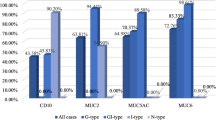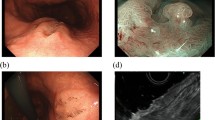Abstract
The aim of this study was to evaluate the usefulness of gastric and intestinal epithelial phenotypic expression of gastric cancer cells, shown by mucin histochemical staining (paradoxical concanavalin A, galactose oxidase Schiff [GOS] and sialidase-GOS) and immunohistochemical reactivity (pepsinogens, SH-9, and TKH-2), as an adjunct to the assessment of depth of invasion of gastric carcinomas by endosonography (ES). In 110 resected adenocarcinomas, the proportion of intestinal-type cells increased with progression, as assessed by depth of invasion. The coincidence rate for gastric and intestinal phenotypic expression in biopsied and resected specimens was 96.3%. The positive predictive value of assessment of depth of invasion by ES was 73%. A low positive predictive value (45%) was achieved with type II-3 cases (according to our classification). However, the predictive value improved to 68% when depth of invasion was evaluated as the submucosal layer or deeper in cases in which more than 10% of cancer cells were of intestinal-type, although statistical analysis showed no significant difference between these predictive values. The sensitivity of diagnosis of submucosal invasion by cell differentiation in the type II-3 cases was significantly higher than that for the other types (89.5% versus 59.1%P=0.037). Phenotypic expression in biopsied specimens of gastric carcinomas proved helpful for evaluating the depth of invasion of gastric carcinoma by ES.
Similar content being viewed by others
References
Iriyam K, Asakawa T, Koike H, et al. Is extensive lymphadenectomy necessary for surgical treatment of intramucosal carcinoma of the stomach? Arch Surg 1989;124:309–311.
Hiki Y, Sakakibara Y, Mieno H, et al. Endoscopic treatment of gastric cancer. Surg Endosc 1991;5:11–13.
Souquet JC, Napoleon B, Poujol B, et al. Echoendoscopy prior to endoscopic tumor therapy—more safety? Endoscopy 1993; 25:475–478.
Calleti G, Bolondi L, Labo G. Ultrasonic endoscopy: The gastrointestinal wall. Scand J Gastroenterol 1984;19(Suppl 102):5–8.
Aibe T, Fuji T, Okita K, et al. A fundamental study of normal layer structure of the gastrointestinal wall visualized by endoscopic ultrasonography. Scand J Gastroenterol 1986; 21(Suppl 123):6–15.
Nakamura T, Nakazawa S, Yoshino J. A study on the depth of cancerous invasion in the gastric wall by endoscopic ultrasonography (In Japanese with English abstract). Nippon Shokakibyo Gakkai Zasshi (Jpn J Gastroenterol) 1986;83:625–634.
Nakazawa S. Manual of endoscopic ultrasonography (in Japannese). Tokyo: Nankodo, 1991:73–87.
Dittler HJ, Siewert JR. Role of endoscopic ultrasonography in gastric carcinoma. Endoscopy 1993;25:162–166.
Ohashi S, Nakazawa S, Yoshino J. Endoscopic ultrasonography in the assessment of invasive gastric cancer. Scand J Gastroenterol 1989;24:1039–1048.
Nakazawa S, Nakamura T, Yoshino J. Endoscopic ultrasonography. Japanese Cancer Association, Gann Monograph on Cancer Research No 37. Tokyo: Japanese Scientific Societies Press and London: Taylor and Frances, 1990:41–56.
Tio TL, Coene PPLO, Luiken GJHM, et al. Endosonography in the clinical staging of esophagogastric carcinoma. Gastrointest Endosc 1990;36:S2-S10.
Yasuda K, Mukai H, Cho E, et al. Evaluation of the degree of gastric cancer invasion by endoscopic ultrasonography (EUS) for endoscopic treatment of early disease (in Japanese with English abstract). Stomach and Intestine 1992;27:1167–1174.
Kida M, Yamaha Y, Sakaguchi T, et al. The diagnosis of gastric cancer by endoscopic ultrasonography (in Japanese with English abstract). Stomach and Intestine 1991;26:61–70.
Tatematsu M, Hasegawa R, Ogawa K, et al. Histogenesis of human stomach cancers based on assessment of differentiation. J Clin Gastroenterol 1992;14(Suppl 1):S1-S7.
Tatematsu M, Iwata H, Ichinose M, et al. Markers of surface mucous cell type human gastric cancer cells: Galactose oxidase-Schiff reactive mucins, monoclonal antibody SH-9 reactive mucins and cathepsin E. Acta Pathol Jap 1993;43:500–506.
Iwata H, Steven SI, Lawrence JW, et al. Expression of sialosyl-Tn in intestinal type cancer cells of human gastric cancers. Acta Pathol Jap 1993;43:646–653.
Tatematsu M, Kato T, Ogawa K, et al. Changes of cellular differentiations of gastric cancer cells with progression (only abstract in English). In: Procs of the Japanese Research Society for Gastroenterological Carcinogenesis 1990;2:213–216.
Kushima R, Jancic S, Hattori T, et al. Association between expression of sialosyl-Tn antigen and intestinalization of gastric carcinomas. Int J Cancer 1993;55:904–908.
Tatematsu M, Furihata C, Katsuyama T, et al. Gastric and intestinal phenotypic expressions of human signet ring cell carcinomas revealed by their biochemistry, mucin histochemistry, and ultrastructure. Cancer Res 1986;46:4866–4872.
Tatematsu M, Furihata C, Katsuyama T, et al. Independent induction of intestinal metaplasia and gastric cancer in rats treated with N-methyl-N′-nitro-N-nitrosoguanidine. Cancer Res 1983;43:1335–1341.
Tatematsu M, Furihata C, Katsuyama T, et al. Stable intestinal phenotypic expression of gastric and small intestinal tumor cells induced by N-methyl-N′-nitro-N-nitrosoguanidine or methylnitrosourea in rats. Gann 1984;75:957–965.
Tatematsu M, Yamamoto M, Iwata H, et al. Induction of glandular stomach cancers in C3H mice treated with N-methyl-N-nitrosourea in the drinking water. Jpn J Cancer Res 1993;84:1258–1264.
Author information
Authors and Affiliations
Rights and permissions
About this article
Cite this article
Nakamura, T., Suzuki, T., Kobayashi, S. et al. Histochemical and immunohistochemical study of human gastric carcinoma differentiation with special reference to supplementary role for endosonography in evaluating depth of invasion. J Gastroenterol 32, 176–183 (1997). https://doi.org/10.1007/BF02936364
Received:
Accepted:
Issue Date:
DOI: https://doi.org/10.1007/BF02936364




